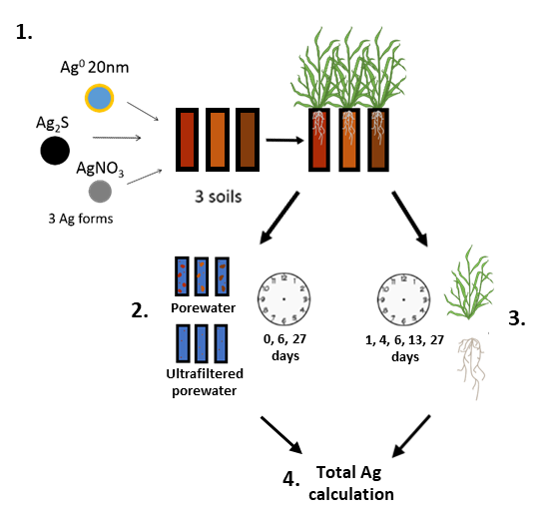NanoFASE Case Study: Influence of Differing Soil Properties on Uptake of Ag-NP Forms in Wheat
Silver nanoparticles can enter the soil through the application of sewage sludge to agricultural land. The silver in the sewage sludge will most likely be in the transformed, sulphidised form. Plants growing on this agricultural land will thus be exposed to silver and have to potential to accumulate silver in their tissues. Varying soil properties can affect the bioavailability and bio-uptake in plants ; NanoFASE has therefore investigated the effect of a range of soils upon the bio-uptake of silver to plant tissues in the crop plant, Triticum aestivum (wheat).
Study aim |
|
|
This study investigates the uptake of Ag from different Ag forms (Ag0 Engineered NanoMaterials , Ag2S ENM and AgNO3) in wheat, Triticum aestivum, exposed in three different natural soils (Lufa 2.2, Woburn and North Wales).
|
|
Experimental approach |
Overview |

|
Compartment involved: Soil NP type/size: Ag NP PVP coated - 20nm (AppNano)
Ag2S NP - 27 nm (AppNano)
Species:
Wheat (Triticum aestivum) Bioassay:
Bioaccumulation assay |
Results |
|
- The rate of uptake was highest in the Woburn soil compared to North Wales and Lufa 2.2.
-
The uptake of Ag was highest from the pristine 20 nm Ag NP PVP coated particle, while Ag2S was either lower than or the same as the uptake from the AgNO3 ionic reference.
Parameters |
|
|
Read more |
Read also |
|
"A Tale of Two Synchrotrons" in NanoFASE News Visit the NanoFASE Library to read summaries of these reports: NanoFASE Report D7.2 Soil property – NM fate relationships NanoFASE Report D9.2 Parameter sets on uptake and toxicokinetics of selected pristine NMs in aquatic and terrestrial organisms (summary of internal report)
|
Wang, P., et al. (2015). "Silver sulfide nanoparticles (Ag2S-NPs) are taken up by plants and are phytotoxic." Nanotoxicology 9(8): 1041-1049. Dolette, C. L., et al. (2015). "Bioavailability of silver and silver sulfide nanoparticles to lettuce (Lactuca sativa): Effect of agricultural amendments on plant uptake." Journal of Hazardous Materials 300: 788-795. Stegemeier, J. P., et al. (2015). "Speciation Matters: Bioavailability of Silver and Silver Sulfide Nanoparticles to Alfalfa (Medicago sativa)." Environ Sci Technol. 49(14): 8451-8460. |
Contact
 Amaia Green Etxabe
Amaia Green Etxabe
Centre for Ecology and Hydrology (CEH)
Wallingford, UK
 Elma Lahive
Elma Lahive
Centre for Ecology and Hydrology (CEH),
Wallingford, UK
